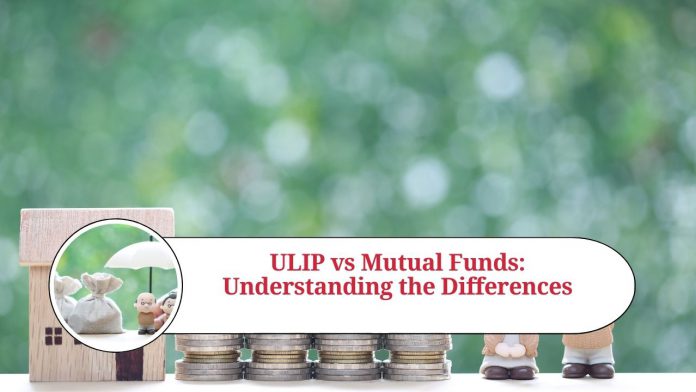When it comes to investing in the stock market, two popular options that often come up are Unit Linked Insurance Plans (ULIPs) and Mutual Funds. While both offer the potential for high returns, there are some key differences between the two that investors should be aware of. In this blog, we’ll take a closer look at ULIPs and Mutual Funds and explore the pros and cons of each.
What are ULIPs?
ULIPs are investment products that combine the benefits of both insurance and investment. When you invest in a ULIP, a portion of your premium goes towards life insurance coverage, while the remaining amount is invested in equity, debt, or a combination of both. ULIPs offer the potential for high returns, but also come with higher risk than traditional insurance policies.
What are Mutual Funds?
Mutual Funds are investment products that pool money from multiple investors and invest it in a diversified portfolio of stocks, bonds, or other securities. Mutual Funds are managed by professional fund managers, who make investment decisions on behalf of the investors. Mutual Funds offer the potential for high returns, but also come with higher risk than traditional savings accounts.
Key Differences between ULIPs and Mutual Funds
- Investment Strategy: ULIPs invest a portion of your premium in a mix of equity, debt, and other investment instruments, while Mutual Funds invest in a diversified portfolio of stocks, bonds, or other securities.
- Insurance Component: ULIPs offer life insurance coverage, while Mutual Funds do not.
- Cost Structure: ULIPs typically have higher fees and charges than Mutual Funds, due to the added insurance component.
- Liquidity: Mutual Funds are more liquid than ULIPs, as they can be easily bought and sold on the stock market.
- Tax Benefits: ULIPs offer tax benefits under Section 80C and Section 10(10D) of the Income Tax Act, while Mutual Funds offer tax benefits under Section 80C only.
Pros and Cons of ULIPs Pros:
- Offer life insurance coverage in addition to investment.
- Offer tax benefits.
- Can provide higher returns than traditional insurance policies.
- Premiums can be customized based on the investor’s risk profile and investment goals.
Cons:
- Higher fees and charges.
- Lower liquidity.
- Limited investment options.
- Can be complex and difficult to understand.
Pros and Cons of Mutual Funds Pros:
- Diversified portfolio of investments.
- Professional management by fund managers.
- High liquidity.
- Lower fees and charges than ULIPs.
Cons:
- No life insurance coverage.
- No guaranteed returns.
- Higher risk than traditional savings accounts.
- Limited customization options.
In conclusion
both ULIPs and Mutual Funds offer the potential for high returns, but they differ in their investment strategy, cost structure, liquidity, and tax benefits. Investors should carefully consider their investment goals, risk tolerance, and financial needs before choosing between the two. It is also important to do thorough research and consult with a financial advisor before making any investment decisions.
Read more useful content:
- How to invest in mutual funds
- All about mutual funds-types & importance
- The Power of SIP Investment in Mutual Funds
Frequently Asked Questions (FAQs)
Q: What is a ULIP?
A: ULIP stands for Unit Linked Insurance Plan. It is an investment product that combines the benefits of both insurance and investment. When you invest in a ULIP, a portion of your premium goes towards life insurance coverage, while the remaining amount is invested in equity, debt, or a combination of both.
Q: What is a Mutual Fund?
A: A Mutual Fund is an investment product that pools money from multiple investors and invests it in a diversified portfolio of stocks, bonds, or other securities. Mutual Funds are managed by professional fund managers, who make investment decisions on behalf of the investors.
Q: How does the investment strategy of ULIPs differ from Mutual Funds?
A: ULIPs invest a portion of your premium in a mix of equity, debt, and other investment instruments, while Mutual Funds invest in a diversified portfolio of stocks, bonds, or other securities.
Q: Do ULIPs offer life insurance coverage?
A: Yes, ULIPs offer life insurance coverage in addition to investment.
Q: Do Mutual Funds offer life insurance coverage?
A: No, Mutual Funds do not offer life insurance coverage.
Q: What is the cost structure of ULIPs and Mutual Funds?
A: ULIPs typically have higher fees and charges than Mutual Funds, due to the added insurance component.
Q: Which investment option is more liquid – ULIPs or Mutual Funds?
A: Mutual Funds are more liquid than ULIPs, as they can be easily bought and sold on the stock market.
Q: Do ULIPs offer tax benefits?
A: Yes, ULIPs offer tax benefits under Section 80C and Section 10(10D) of the Income Tax Act.
Q: Do Mutual Funds offer tax benefits?
A: Yes, Mutual Funds offer tax benefits under Section 80C of the Income Tax Act.
Q: Which investment option is more customizable – ULIPs or Mutual Funds?
A: ULIPs offer more customization options than Mutual Funds, as premiums can be customized based on the investor’s risk profile and investment goals.
Q: Which investment option carries higher risk – ULIPs or Mutual Funds?
A: Both ULIPs and Mutual Funds come with higher risk than traditional savings accounts. However, the level of risk may vary depending on the specific investment strategy and portfolio composition. It is important to carefully evaluate the risk involved before making any investment decisions.




















